Your stance and golf grip are the two most important fundamentals to master to play a decent round of golf. The challenge is that there is no one-size-fits-all answer when asking how to grip a golf club?
But there are specific actions you can take to improve your grip. Below you’ll learn how to improve your personal grip, including step-by-step techniques, the best types, and how much pressure to use.
How to Grip a Golf Club
Before we look at the 3 most popular types of golf grip, there are some essentials to contemplate on how to hold a golf club. If you want to know how to hold the golf club right-handed, your pink finger on the right hand will slide over the top of the middle finger with the index finger on the left hand.
The lion’s share of golfers grip their clubs, including the putter, which we are not discussing here, between 75 and 105 times a round. It is imperative that the essentials like how to hold a golf club are dealt with and understood to improve scores and lower handicaps.
To achieve the best contact between ball and club, the clubface must be square at impact. The proper positioning of both your hands on the grip combined with the items explained below will make it possible for this to occur frequently.
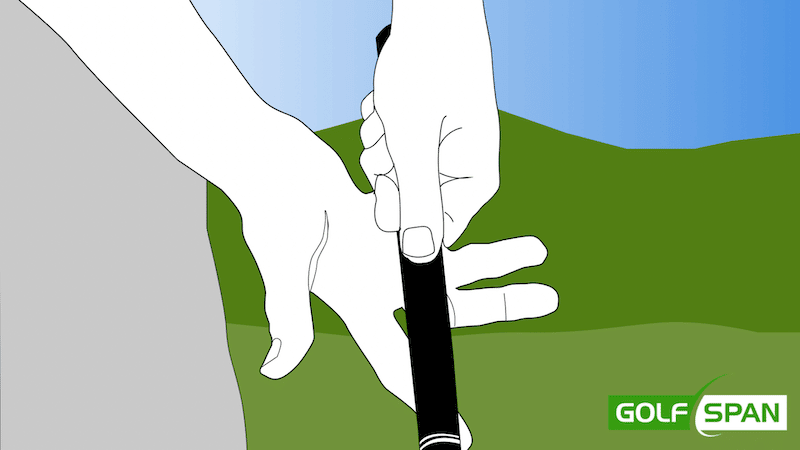
The Proper Golf Grip is a Two-Part Process:
- Your top hand is placed on the highest spot on your handle.
- Then, place your bottom hand on the grip.
There are Two Techniques Applied Most Frequently to Get the Grip Correct:
- Lay the grip in the palm of your fingers, placing your left thumb right of center for the ideal neutral grip.
- Add your right hand to the grip with the middle two fingers and forefinger interacting with the club handle. Ideally, your right thumb should be left of the center in the finalized grip. This is the proper golf grip left-hand position.
Grip Strength
Let us first address the 3 different grips’ strengths. We are not implying the tension placed on the grip. Instead, when we refer to how to grip a golf club properly in this context, we’re referring to the hand placement on your golf club.
1. Neutral Grip
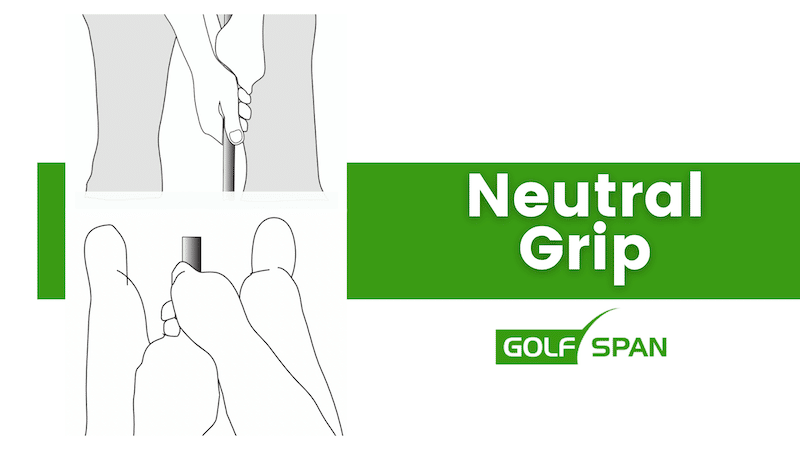
The neutral grip has a natural propensity to turn the clubhead toward a square impact position, thus producing a straight ball trajectory. Neither of your hands becomes dominant during the golf swing.
To produce a neutral grip, start by positioning your clubface square to the ball at address, then place your leading hand on the handle and ensure that only the two knuckles of your index finger and middle finger of the leading hand are detectable when looking down at it.
To do this golf grip, add your trailing hand at a lower point to the handle in a mirror image of your leading hand and the palms facing each other. As per the leading hand, only the two knuckles of the index finger and the middle finger of the trailing hand should be detectable. That’s the hand placement golf club positions for the neutral grip.
The neutral grip produces 2 V’s facing marginally to the right of your nose for right-handed golfers.
2. Strong Grip
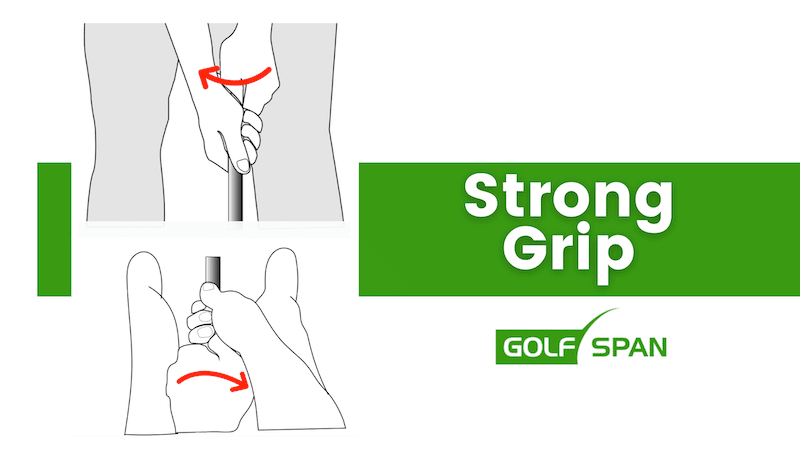
The strong grip will produce a closed clubface at impact and generate left-to-right ball trajectories, resulting in a draw or a hook. A strong grip will allow your dominant hand to turn over further away from the middle of the handle, causing it to turn over more in the course of the golf swing. The non-dominant hand will turn over the middle of the handle, following the dominant hand.
A strong grip is produced by positioning your leading hand on the handle and moving it toward your dominant hand. At this juncture, the knuckle of the ring finger ought to be detectable in addition to the two knuckles that are detectable from the neutral grip.
The V formed between your thumb, and index finger should point to your dominant shoulder. For right-handed golfers, the V must point to your left shoulder, and the contrary for left-handed golfers.
Now similarly position the trailing hand to the neutral grip. The palms should face each other. The V formed by the trailing hand, thumb and index finger should be pointing to the same shoulder as the leading hand.
A perfectly executed strong grip will result in the Vs formed by your thumbs and index fingers aiming in the direction of your dominant shoulder.
3. Weak Grip
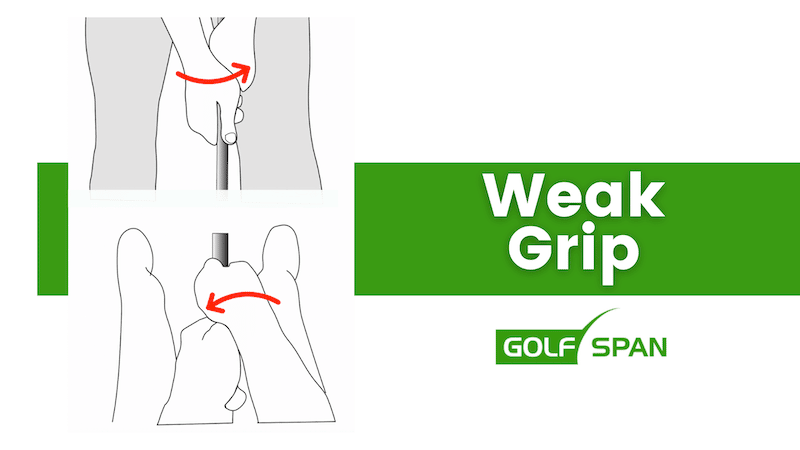
As the name implies, it’s a weak grip pressure. A weak grip is the inverse of a strong grip, and the hands are more oriented to the non-dominant side. This golf grip will result in the hands not turning over and will lead to an open clubface at impact and a left-to-right ball trajectory.
To produce a weak grip, the leading hand is positioned on the handle facing away from your dominant shoulder, and only the knuckle on your index finger is detectable at address.
Positioning your trailing hand on the handle and the palms facing each other results in the V’s formed, pointing to your non-dominant shoulder.
3 Types of Golf Grip
Now that we have explained the various ways to hold a golf club, let us consider how to link up your fingers to the handle. You have three types of golf grip hand positions. There is no perfect way, and the type that feels the most secure and comfortable would be the one that is the most suitable to embrace.
Golfers of all levels employ various types of grip position golf choices from beginners to professional golfers, and your chosen golf grip is contingent on the golfer’s hand size and personal preference. Where you put your golf grips hands will depend on the positions we will cover here.
1. Vardon Grip
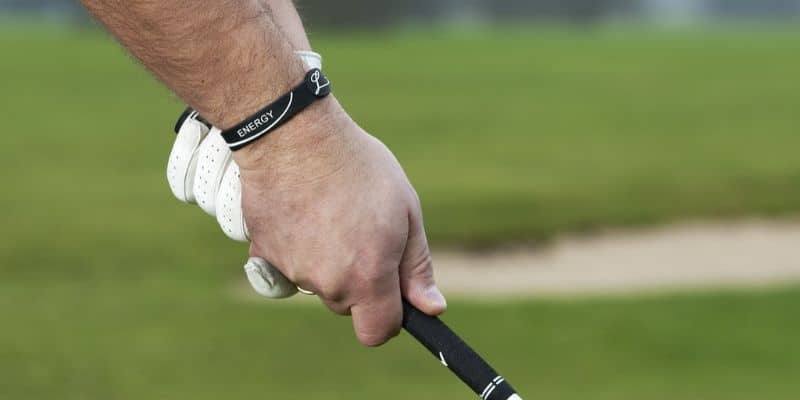
First of all, let us examine the Vardon Grip that was made fashionable by the famed British golfer Harry Vardon at the turn of the 20th century and remains as the most prevalent golf grip with top golfers. Golfers with larger hands and longer fingers will find this a more comfortable and suitable golf grip. It is also often described as the overlapping grip since the pinkie finger of your trailing hand overlays the groove between the index finger and middle finger of your leading hand. The thumb of the lead hand should fit into the lifeline of the trailing hand.
2. Interlocking grip
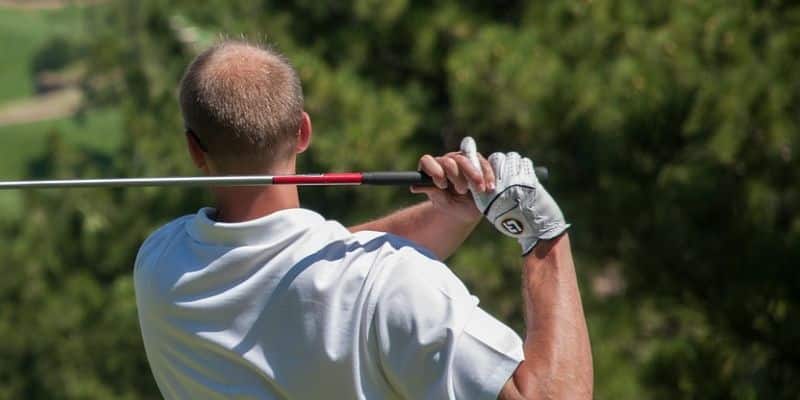
Following the Vardon grip, the interlocking grip is the most frequently used grip by golfers. It is often used by those with slightly smaller hands and shorter fingers. It is particularly prevalent on the LPGA tour but similarly frequently used by male golfers on the PGA tour.
Top golfers that have adopted this grip are Jack Nicklaus and Tiger Woods.
As with the Vardon grip, the hands connect via the trailing hand’s little finger and the leading hand’s index finger. While the fingers overlap in the Vardon grip, they interlock with each other in the interlocking grip. This interlocking action boosts control as the hands are held tightly together through the interlocking position. The thumb of the lead hand must fit in the lifeline of the trailing hand.
3. Ten Finger Grip / Baseball Grip
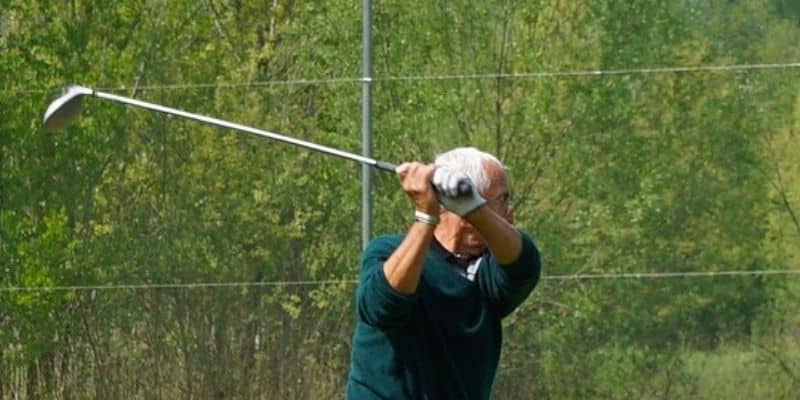
Finally, we will clarify the least favorite golf club grip among golfers and coaches alike. Similar to the grip used on a baseball bat, the hands are positioned underneath each other with no connection between the hands, unlike the first two grips.
Golfers prefer this grip with difficulty flexing their arthritic fingers, or golfers with exceptionally small hands and short fingers such as juniors, as this grip is fairly instinctive to hold onto.
If you want to know how to grip a golf club with this technique properly, the lead hand is placed on the handle first, followed by the trailing hand. The hands are pushed together, with the little finger of the trailing hand touching the index finger and perhaps the thumb of the trailing hand. The lead thumb hand ought to cover with the lifeline of the trailing hand.
While not extremely popular, it works for many golfers, and many find that it gives them more power. Choose the hand placement that feels the most comfortable, but experiment to see what will give you the best results. There is no proper golf grip or how to hold a golf club, but you have a couple of main ways to do it.
This video will give you more insights into the type of golf grips.
Step-by-Step Proper Golf Grip Guide
Sam Snead, the PGA Hall of Famer, once said, “If people gripped the knife and fork the way that they do a golf club, they’d starve to death.” With that in mind, let’s look at how to grip your golf club better.
Step #1: Understanding Your Grip Size
Every club will feature a different grip size, but understanding the grip size on your club will let you find a comfortable grip. The grip is the rubberized club part where your hands will go. Larger grip sizes will give you extra room for where to place your hands, making the grip easier.
Step #2: Club Positioning
Next, you position the club right before you. Grab the club but don’t think too much about the hand positioning. Instead, we want you to think more about how comfortable it feels. Hold the club as comfortably as you can.
Step #3: How to Grab the Club
Whether left-handed or right-handed, in almost every case, the left-hand goes before the right hand. You take the right hand and overlap it with the middle and ring fingers. Why? Few golfers who put the right hand first on the club play as good of a game of golf, making this the standard.
Step #4: Choose a Golf Grip
In the following step, you choose a golf grip. Remember that you need to build muscle memory on your grip, so you may not succeed at it immediately. You want your hands to go into that grip naturally when you go to grip, and this can take time. However, the starting base should always feel the most comfortable.
Step #5: Experiment as a Beginner
As a beginner, you want to experiment with the different grips previously mentioned until you find what delivers the best results. You may not get it right on the first try. For an older golfer with arthritis, you may want to go straight to the Baseball Grip. For those with smaller fingers, try the Interlocking Grip. Keep trying out the grips until you can decide what works best for you.
Why Does Proper Golf Grip Matter?
The golf grip matters because how you position your hands will affect the point of impact. This little detail will impact your golf swing, one of the most important factors in doing well in golf. In addition, without proper grip, the club may swing right out of the hands and create a dangerous scenario.
When you go to grip the club, you want fluid movement of your wrists because they flick at the bottom of the swing. Good grip will teach you the moment when to flick your wrists.
Long Thumb Grip vs Short Thumb Grip
Should you use the long thumb grip or the short thumb grip? Generally speaking, short thumb grips lead to a shorter golf swing. If you struggle to stay balanced, this is a better grip for you because of less movement. You can execute your motion with fewer working parts, making things easier.
We would especially recommend the short thumb grip for beginner golfers because it tends to be easier for them.
On the other hand, you have a long thumb grip, which makes a full wrist hinge easier to achieve. You feel more room with your two middle fingers on the right hand. The wrists move into more of a neutral position, and you feel increased stability.
How Much Grip Pressure Should You Use?
In general, the grip pressure should neither be too tight nor too light. If you had to measure it at a scale of 1 to 10, you would want to put your grip pressure right between 4 and 5. You do want it slightly lighter because it will enhance your wrist hinge.
If your pressure is too tight, many problems can arise. For example, your swing might become jerky, or you might see reduced clubhead speed. On the other hand, if you don’t put enough pressure on your hands, the club could fly right out of your hands. You need to find the sweet spot for pressure.
Sam Snead once said that you should imagine like you’re holding a baby bird. You don’t want to hold it too lightly, or the bird will fall out of your hands. Hold it too tightly, and you will squish the bird. The same rule applies to how much pressure you use.
What Do You Do if Your Golf Grip Feels Uncomfortable?
Let’s say that the grip you use now feels uncomfortable. Instead of switching it out immediately, consider sticking with it for a while. All fundamental changes to how you swing the club will take time. In other words, it won’t feel perfect on your first attempt.
You have to take the time to learn the grip. Just keep in mind that it can take up to six months for a beginner to master hitting the ball. Granted, this includes all the other things as well, but the golf grip is a part of this mastery. You won’t learn it on the first try.
Read More: Does an Oversized Grip Improve Your Game?
FAQs
How Do You Hold a Golf Club with Your Right Hand?
First, you will put your left hand on the club, and next, you put your right hand on the club to overlap the middle and ring fingers. You do this because very few good golfers will put the right hand first. The left hand always goes before the right.
How Do You Hold a Golf Club with Your Left Hand?
When you go to hold the golf club with your left hand, you always put the left hand before you put the right hand on it. The reasoning behind this is that golfers tend to do better this way.
How Do You Place Your Hands on a Golf Club?
When you go to place your hands on the golf club, you usually put your left hand first on the club, and you follow it up with your right hand. The right hand overlaps the middle and ring fingers on the club.
How Far Down Should You Grip a Golf Club?
In most cases, you want to put your left hand 1 inch down from the top of the golf club. After that, you put your right hand over the left at the point of the middle and ring finger because this ensures that you have the best grip on the club. It increases your control.
How Do I Grip the Putter?
When you go to grip the putter, the right-hand goes over the left thumb, which sits at the top of the putter grip. The fingers of the right hand will wrap around the side to slip under the left index finger.
Should I Use the Same Grip for My Irons and Driver?
Most golfers will use the same grips for the irons and drivers; generally, it doesn’t make a big difference. Usually, when players grip their driver, they make a few more accommodations, but there isn’t a huge difference. Using the same grip throughout will promote greater consistency.
Final Thoughts
It is certainly worth considering your golf grip as it will have a major impact on your performance. This might require a bit of experimenting on how you grip the club to determine what works best for you, but learning how to hold a golf club will improve your golf game. The perfect golf grip feels comfortable and delivers the results, but remember that there is no best way to grip golf club.
Take the time to learn how to grip a golf club and spend your time with it. You will see your performance improve drastically, and the correct golf grip is as important as working on your swing because this will impact your swing. Hopefully, this shows you the different types of golf grips that you can use to enhance your golf game.
Related Articles
- How Much Does it Cost to Regrip Golf Clubs?
- The 10 Common Golf Problems Every Beginner Makes
- The Best Drivers Golf Grips
Nick is the founder of GolfSpan and an avid golfer. He's not quite a pro but has over 15 years of experience playing and coaching golfers worldwide. His mission is to bring the golfing community a better experience when it comes to choosing the right golf gear and finding the right setup for your game.






